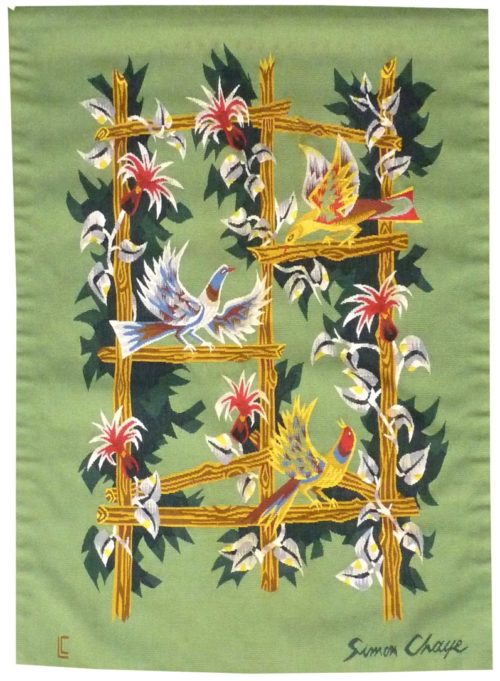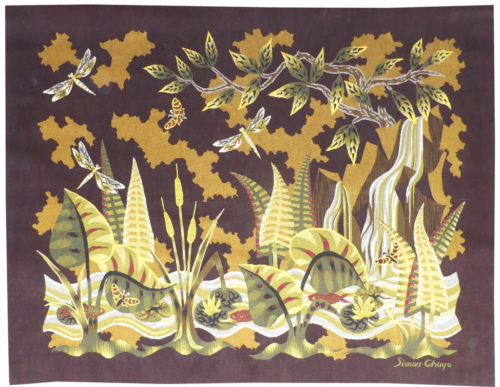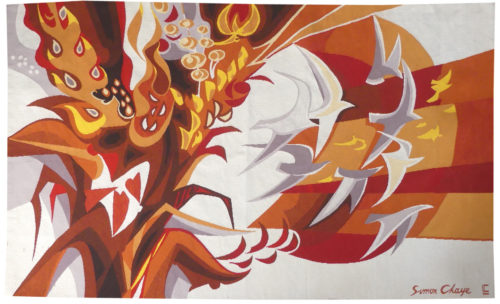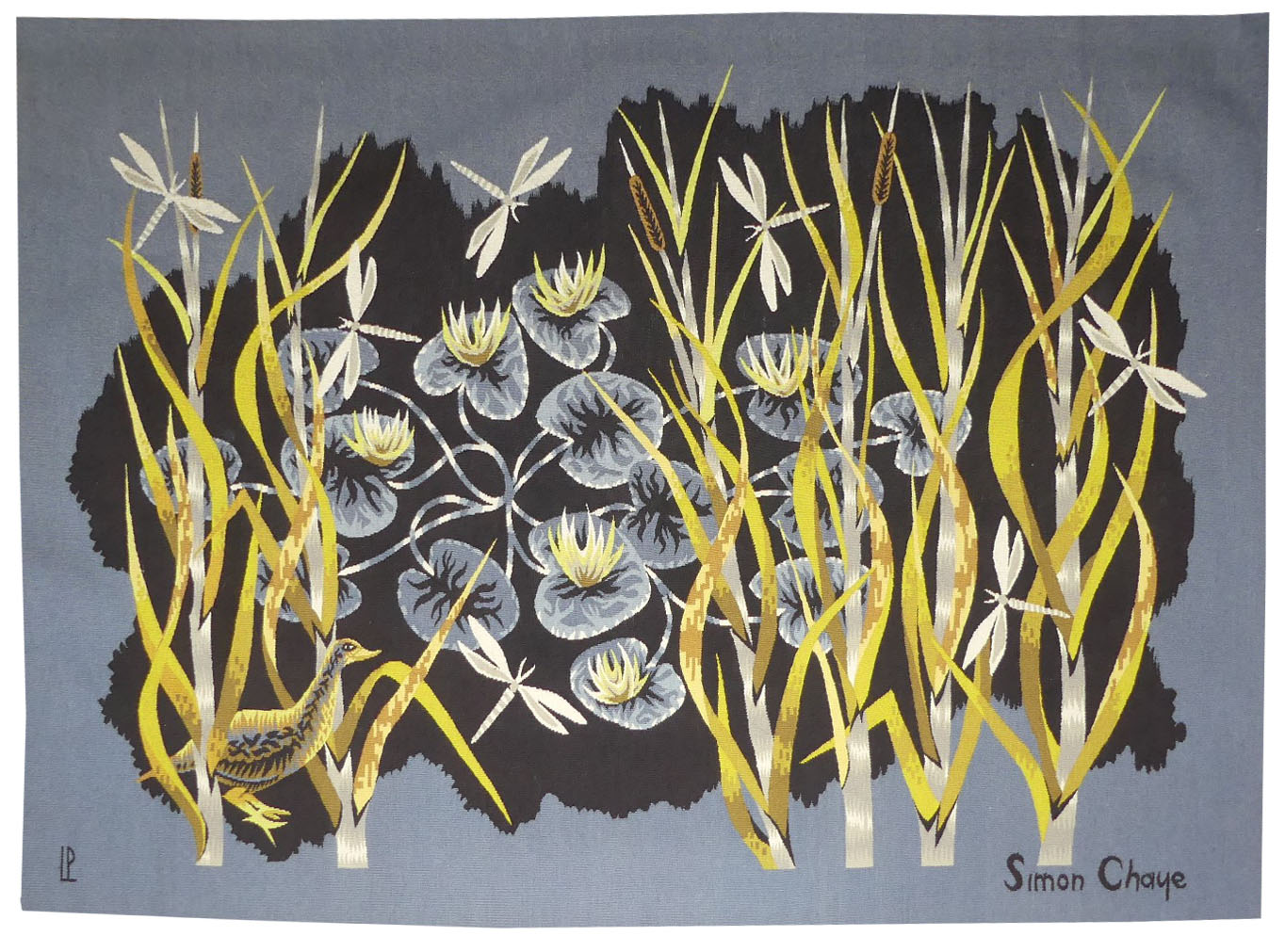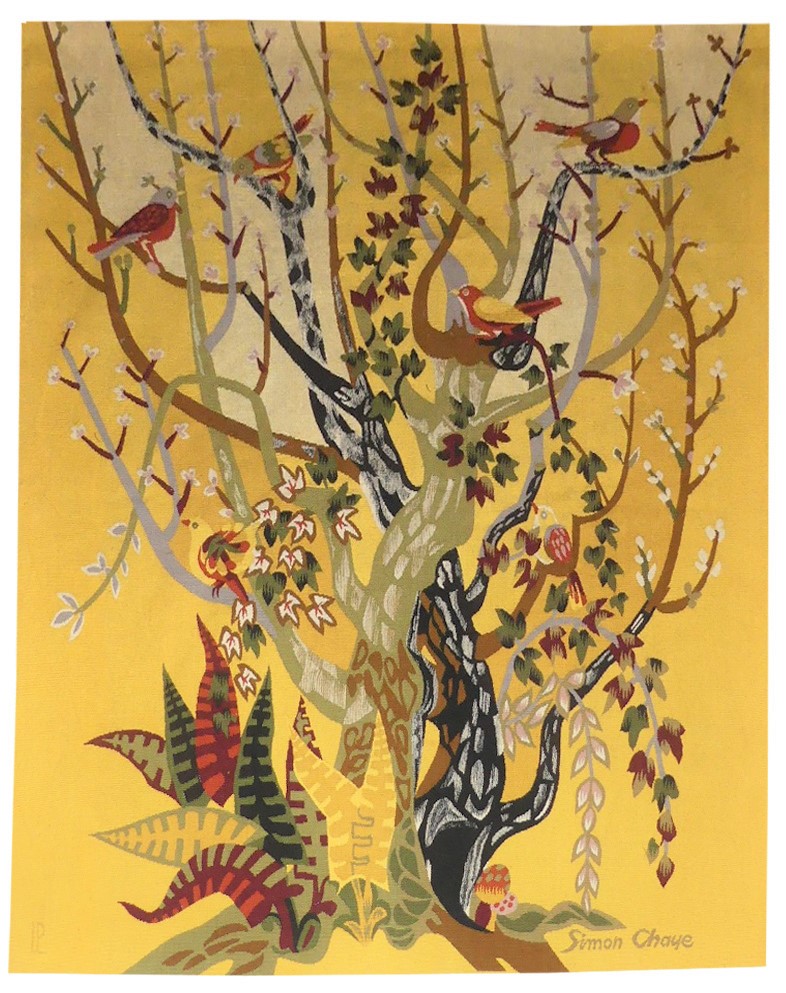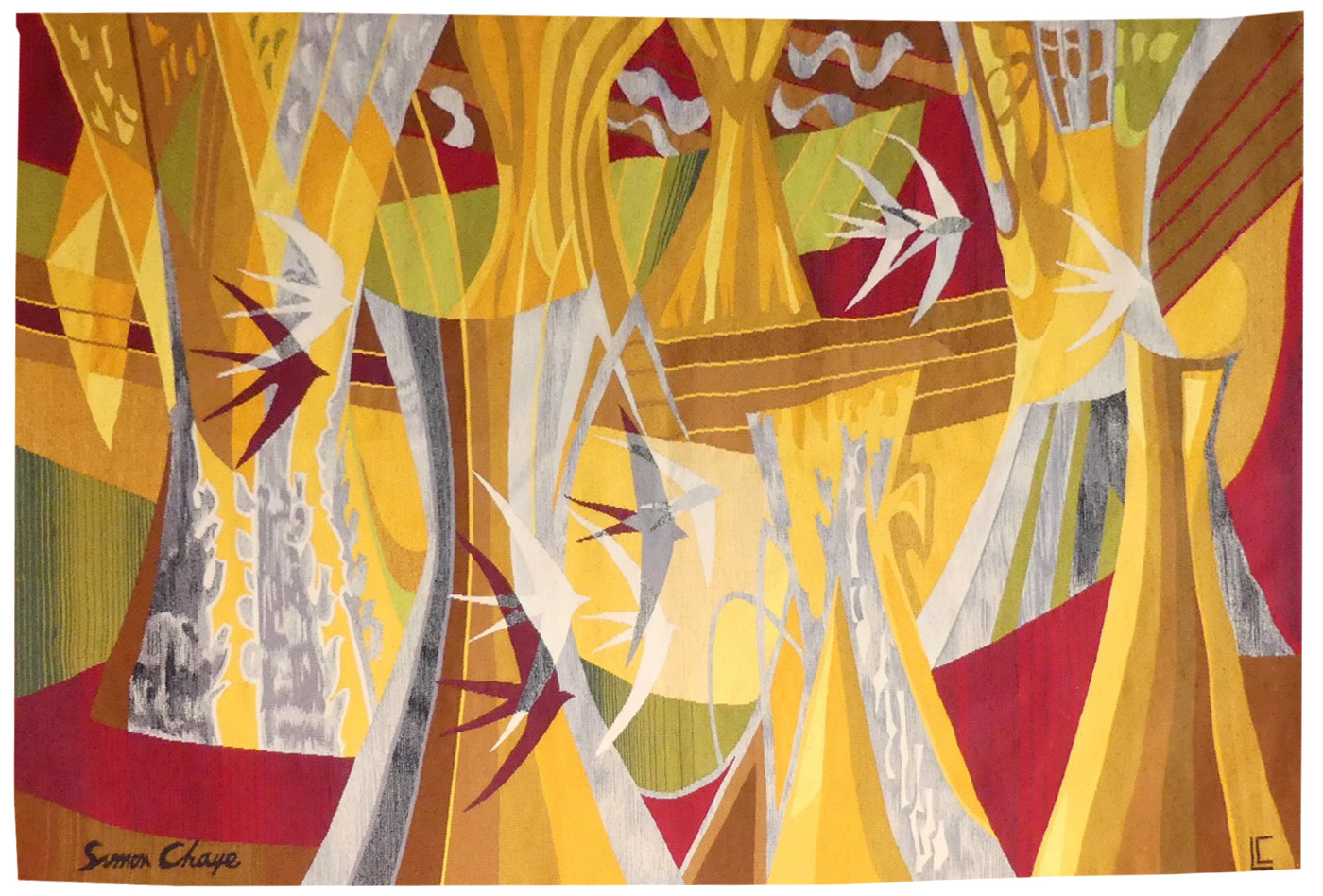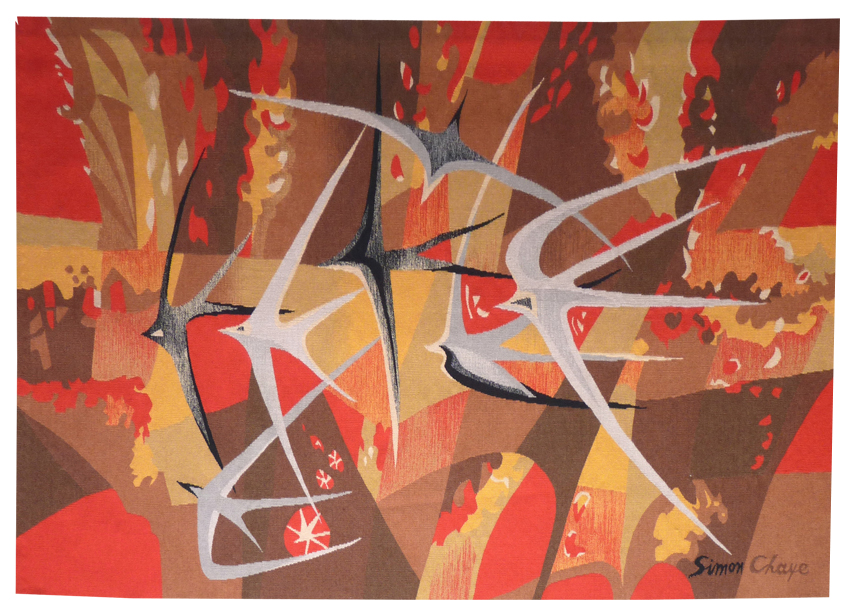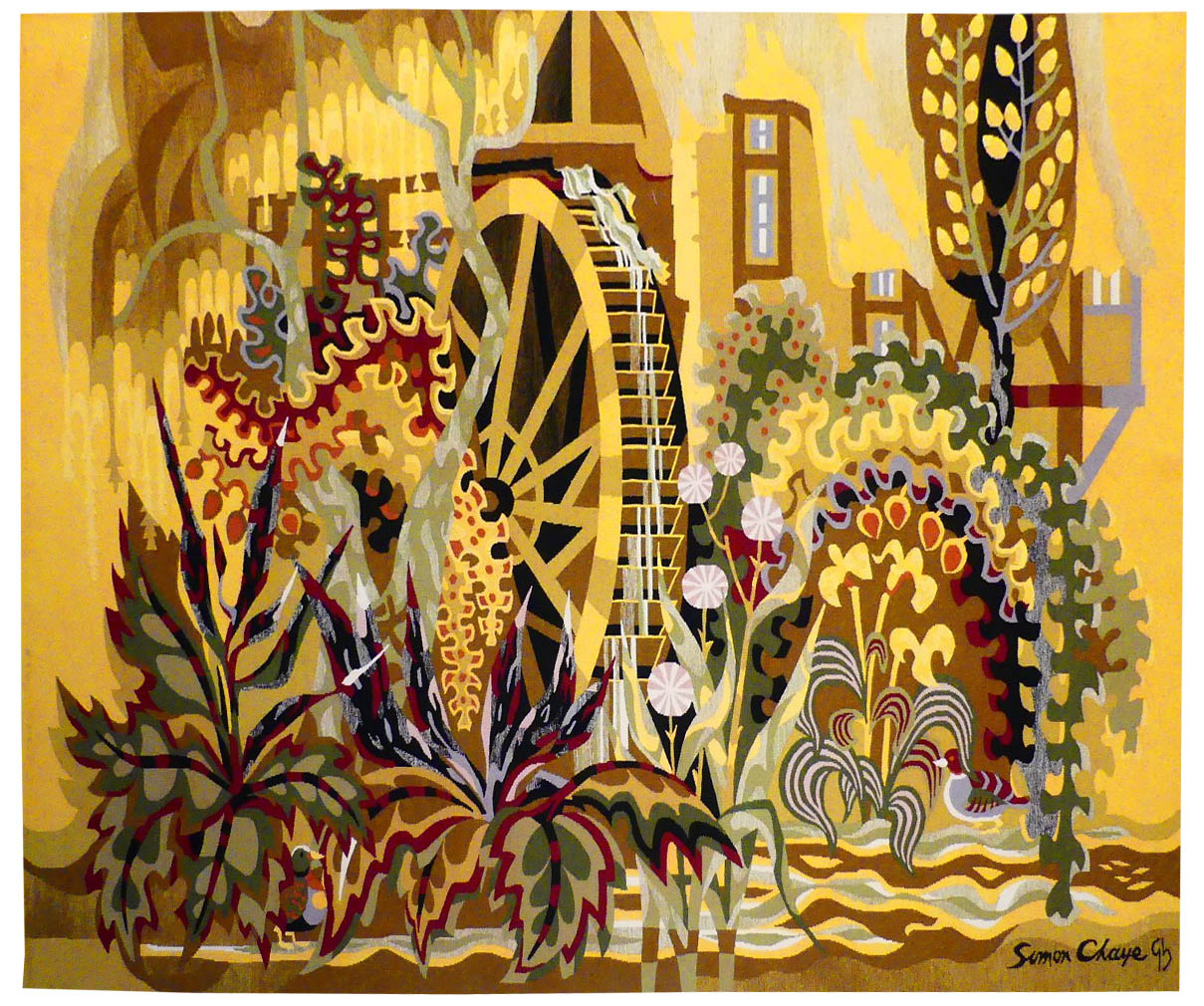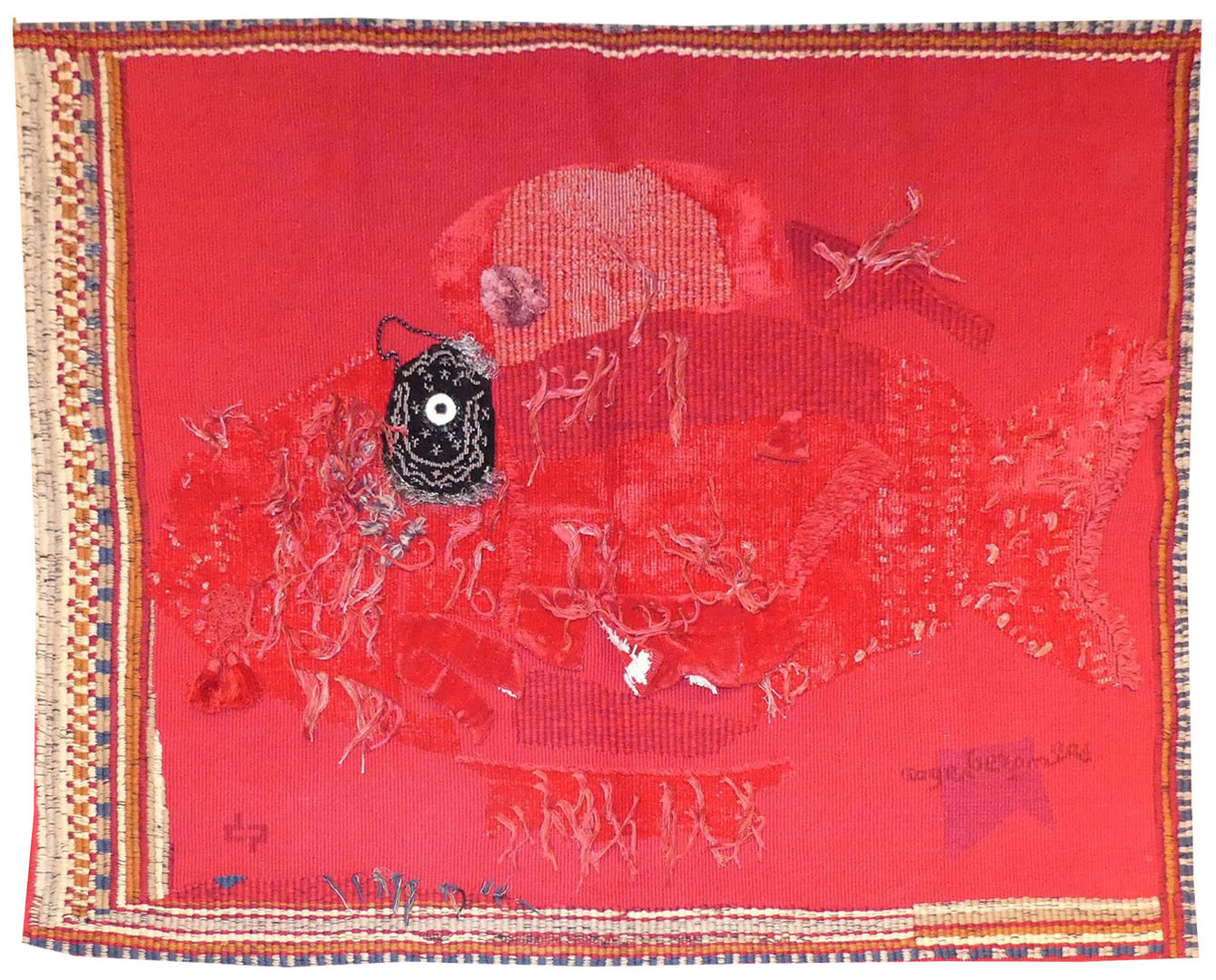-
Aubusson tapestry woven in the Bonjour workshop. With signed label, n°3/4. 1973.It was in 1953 that Jean Picart le Doux proposed to Chaye to become his assistant and encouraged him to design tapestry cartoons : he would produce numerous bucolic cartoons, but also views of Normandy (Mont Saint Michel, Honfleur, regattas,…) whence he came.A classic cartoon in the naturalistic vein of this particular artist, who made a speciality of enclosures, hedges and riverbanks with animals.Bibliography : Simon Chaye tapisseries contemporaines, Editions Librairie des musées, 2014, ill. p.41
-
Soleil rouge (Red sun)
Aubusson tapestry woven in the Legoueix workshop. With signed label, n°1/6. 1989.It was in 1953 that Jean Picart le Doux proposed to Chaye to become his assistant and encouraged him to design tapestry cartoons : he would produce numerous bucolic cartoons, but also views of Normandy (Mont Saint Michel, Honfleur, regattas,…) whence he came. A design which brings together two leitmotivs characteristic of Simon Chaye, a bouquet and a flock of birds, which here detach themselves from a background formed by the red sun.Bibliography : Simon Chaye tapisseries contemporaines, Editions Librairie des musées, 2014, ill. p.120 -
L'étang (the pond)
Aubusson tapestry woven in the Legoueix workshop. With signed label, n°6/6. Circa 1965.It was in 1953 that Jean Picart le Doux proposed to Chaye to become his assistant and encouraged him to design tapestry cartoons : he would produce numerous bucolic cartoons, but also views of Normandy (Mont Saint Michel, Honfleur, regattas,…) whence he came. An exact reproduction of the cartoon “Nénuphars” (waterlilies), the only difference being the change of the background colour from the original green.Bibliography : Simon Chaye tapisseries contemporaines, Editions Librairie des musées, 2014 -
Eclosion (hatching)
Aubusson tapestry woven by the Legoueix workshop. With signed label, n°1/6. Circa 1970. It was in 1953 that Jean Picart le Doux proposed to Chaye to become his assistant and encouraged him to design tapestry cartoons : he would produce numerous bucolic cartoons, but also views of Normandy (Mont Saint Michel, Honfleur, regattas,…) from whence he came. Here is a thoroughly characteristic cartoon of this artist who specialises in pastures, hedges and woodland scenes. Bibliography : Simon Chaye tapisseries contemporaines, Editions Librairie des musées, 2014 -
Gerbe (Sheaf)
Aubusson tapestry woven by the Legoueix workshop. N°4/6. 1985. It was in 1953 that Jean Picart le Doux proposed to Chaye to become his assistant and encouraged him to design tapestry cartoons : he would produce numerous bucolic cartoons, but also views of Normandy (Mont Saint Michel, Honfleur, regattas,…) whence he came. These compositions “as the bird flies” are typical of the artist. Here, the fields beneath their wings, in a geometrical evocation of the countryside in summer, are associated with a magnified (or metaphorical) representation of the crops planted therein (wheat, corn,…). Bibliography : Simon Chaye tapisseries contemporaines, Editions Librairie des musées, 2014, ill. p.80 -
Survol (flying over)
Aubusson tapestry woven by the Legoueix workshop. With signed label, n°5/6. 1974. It was in 1953 that Jean Picart le Doux proposed to Chaye to become his assistant and encouraged him to design tapestry cartoons : he would produce numerous bucolic cartoons, but also views of Normandy (Mont Saint Michel, Honfleur, regattas,...) whence he came. These compositions “as the bird flies” are typical of the artist. Bibliography : Simon Chaye tapisseries contemporaines, Editions Librairie des musées, 2014, ill. p.83 -
Moulin (mill)
Aubusson tapestry woven by the Glaudin-Brivet workshop. With label, n°3/6. 1974. Bibliography : Simon Chaye tapisseries contemporaines, Editions Librairie des musées, 2014, ill. p.40 -
Poisson cardinal (cardinal fish)
Tapestry woven in the Saint-Cyr workshop. With signed label, n°EA2. 1978.Roger Bezombes was a proponent of monumental art from the beginning. He received numerous commissions for tapestries on behalf of the state which were woven first at the Gobelins and then at Aubusson, particularly with the Hamot workshop whose dyers were able to produce for him wools to match exactly the colours used for his cartons (which he painted himself to scale). In 1952-53, he produced a monumental set (300 m2) for the pavilion of the French colonies at the Cité Universitaire de Paris. He abandoned the weaving technique at the end of the 1950’s in favour of hangings made of assembled fabrics. These murals (one of the first of which « la Musique », 25m long, was commissioned for France’s broadcasting headquarters La Maison de la Radio) are patchworks made from assembled fragments of cloth, and sometimes other materials, sewn, stuck or stapled together. However, as here, some of his murals were reproduced in tapestry form by the Saint Cyr workshop belonging to Pierre Daquin. In these cases the theme of the fish is omnipresent ; Bezombes however is no ichthyologist, rather a poet : it is the colour, cardinal red, which concerns him here and not the fish of the same name. -
Serpent d'étoiles (serpent of stars)
Aubusson tapestry woven by the Tabard workshop. With signed label. 1961.A member of the A.P.C.T. (Association des Peintres-Cartonniers de Tapisserie), Wogensky is one of the many artists who would follow in Lurçat’s footsteps immediately after the war. At first influenced by his predecessor, Wogensky’s subsequent work (159 cartoons according to the 1989 exhibition catalogue) would evolve during the 1960’s towards a, not completely self-avowed, lyrical abstraction, from cosmic-astronomical themes expressed in decomposed, moving, birdlike shapes to cartoons both more refined and less dense. Although always claiming to be a painter, the artist’s conception of tapestry is extremely well thought out : “the realisation of a mural cartoon…. requires the consideration of a space which is no longer ours alone, by the nature of its dimensions, its scale, it also imposes a grand gesture which transforms and accentuates our presence.” « Serpent d’étoiles » (Serpent of stars) references the constellation Serpens (but also inevitably Giono’s novel of the same name), at a time (the 1960’s) when his out and out lyricism led him to the evocation of celestial bodies, space, the galaxies ; from “Cassiopée” in 1961, “Chant des étoiles” in 1962 (which figured at the Biennale de Lausanne), to “Galaxie” (1970) now in the collection of the French Senate. A similar tapestry figures in the the collection of the Conseil Régional du Limousin. Bibliography : Exhibition Catalogue Robert Wogensky, tapisseries, Galerie la Demeure, 1962, ill. Exhibition catalogue Robert Wogensky, Aubusson, Musée départemental de la tapisserie, 1989 Exhibition catalogue Robert Wogensky, Angers, Musée Jean Lurçat et de la Tapisserie Contemporaine, 1989-1990, ill. p.20 Exhibition Catalogue Dialogues avec Lurçat, Musées de Basse-Normandie, 1992, ill. p.73 Gérard Denizeau, Denise Majorel, une vie pour la tapisserie, Aubusson, Musée départemental de la tapisserie, ill. p.67


